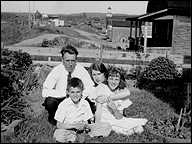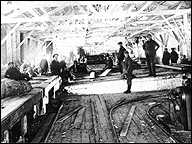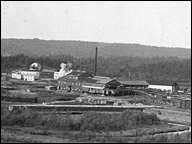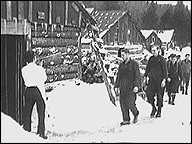Narration and Selected Stills from the Video
Logging by Rail in Algonquin Park
Page 3.
 |
By 1929 a thriving village of 175 people had been created.
A school and a church were built and a sense of community soon developed. |
 |
The company railway was extended 20 kilometers south to
Tea Lake (now North Tea Lake) in Algonquin Park. Quality hardwood
was a specialty. The mill cut up to 100,000 board feet in each ten
hour day. |
 |
When the depression hit in the 1930's the demand for forest
products declined, and a search began for new markets. In order to promote
their lumber in England and elsewhere they produced a film of their operation.
(see video
notes) This film, not shown for over sixty years, follows. It has been
augmented with sound and music. |
 |
The lumberjack's day began with a call to a hearty breakfast in the
cookery. At its peak there where six camps and as many as 400 men inside
the park. Each camp was built to be used for two or three years before
they moved on. Most of the camps where operated by jobbers from the Fassett,
Quebec area, and some by local contractors. Their job was to deliver logs
to the railway in specific quantities and on schedule. |
 Previous,
Next Previous,
Next 
|